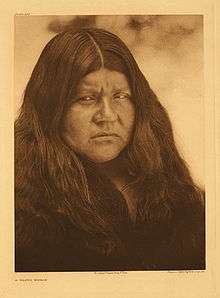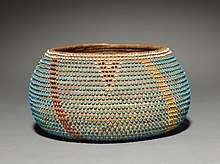Wappo
The Wappo (endonym: Micewal[4]) are an indigenous people of northern California. Their traditional homelands are in Napa Valley, the south shore of Clear Lake, Alexander Valley, and Russian River valley.[3] They are distantly related to the Yuki people, from which they seem to have diverged at least 500 years ago.[4] Their language, Wappo, has been influenced by the neighboring Pomo, who use the term A'shochamai or A'shotenchawi (transcribed as Ashochimi by some authors), meaning "northeners", to refer to the Wappo.[5]
_(20424273785).jpg)
 A Wappo Woman from Edward S. Curtis Collection. | |
| Total population | |
|---|---|
| 1770: 1,000–1,650 1850: 188–200 1910: 73 1977: 50[1] 2000: 250 2010: 291[2] | |
| Regions with significant populations | |
| Languages | |
| English, historically Wappo[1] | |
| Religion | |
| traditional tribal religion | |
| Related ethnic groups | |
| Yuki people[3] |
Culture
The Wappo lived by hunting and gathering, and lived in small groups without centralized political authority, in homes built from branches, leaves and mud. Their woven baskets were so well-crafted that they were able to hold water. The Wappo are an indigenous people of northern California. Their traditional homelands are in Napa Valley, the south shore of Clear Lake, Alexander Valley, and Russian River valley.

History
When Mexicans arrived to colonize California, Wappo villages existed near the present-day towns of Yountville, St. Helena and Calistoga. Those on the south shore of Clear Lake were completely absorbed and dispersed to the Spanish missions in California. The mission accounted for at least 550 Wappo baptisms.[6]
The name Wappo is an Americanization of the Spanish term guapo, which means, among other things, "brave." They were known as brave for their stubborn resistance to Mexican domination, particularly their resistance to all military attempts from General Vallejo and his enlisted allies. In 1836 the warring parties signed a peace treaty.[7][8]
Population
Alfred L. Kroeber put the 1770 population of the Wappo at 1,000.[9] Sherburne F. Cook (1976:174) raised this estimate to 1,650.[6]
By the early 1850s, the surviving Wappo were reported to number between 188 and 800.[10] However population dropped by 1880 to 50, and the 1910 Census returned only 73.[11]
Language
The Wappo language is an extinct member of the Yuki language family. A Wappo grammar has been written.[1]
References
- "Wappo." Ethnologue. Retrieved 16 Dec 2012.
- "2010 Census CPH-T-6. American Indian and Alaska Native Tribes in the United States and Puerto Rico: 2010" (PDF). www.census.gov.
- "Wappo Indians." SDSU: California Indians and Their Reservations. Retrieved 16 Dec 2012.
- Loeb, E. M. (1932). The Western Kuksu Cult (PDF). University of California Press. p. 106. Archived from the original (PDF) on 2019-12-06.
- Kroeber, A. L. (1925). Handbook of the Indians of California. Bureau of American Ethnology. p. 219.
- Cook, p. 174
- 1500 California Place Names: Their Origin and Meaning by William Bright. University of California Press, Berkeley and Los Angeles, 1998.
- Gudde, Erwin; William Bright (2004). California Place Names (Fourth ed.). University of California Press. p. 163. ISBN 0-520-24217-3.
- Kroeber, p. 883
- Cook, pp.239, 351, 357
- Cook, pp. 239, 351
Sources
- Cook, Sherburne F. The Conflict Between the California Indian and White Civilization. Berkeley, CA: University of California Press, 1976. ISBN 0-520-03143-1.
- Kroeber, Alfred L. 1925. Handbook of the Indians of California. Bureau of American Ethnology Bulletin No. 78. Washington, D.C.
External links
- Robert Louis Stevenson State Park
- "Casino at issue in Wappo tribe status". Watch Sonoma County. Retrieved 2012-08-15.
- "Justin-Siena works with Wappo tribe to create 'Braves' mascot". Retrieved 2012-08-15.